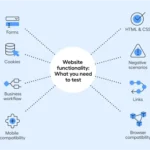Automation technologies are now crucial for enhancing productivity and reducing operating expenses as companies embrace digital transformation more and more. Although online automation and robotic process automation (RPA), two frequently used words, are not synonymous, they are sometimes used interchangeably.
Although automating repetitive chores is the goal of both, their applications, capacities, and scope are very different. We’ll analyze use cases, examine the main distinctions between RPA and web automation solutions, and assist you in choosing the best option for your company in this blog article.
What is RPA (Robotic Process Automation)?
Robotic Process Automation (RPA) refers to software that mimics human actions to automate entire business processes across multiple systems—such as web applications, desktop software, databases, and more.
RPA tools operate at the user interface level, performing tasks the same way a human would, such as clicking buttons, reading data from documents, or moving files between folders.
Common RPA Tools:
- UiPath
- Automation Anywhere
- Blue Prism
- Power Automate
Typical Use Cases:
- Processing invoices from email attachments
- Extracting and inputting data across ERP and CRM systems
- Generating and sending reports across channels
- Performing rule-based workflows like employee onboarding
What is Web Automation?
Web automation, on the other hand, specifically refers to automating tasks performed in a web browser. It deals primarily with automating website interactions, such as filling out forms, scraping data, navigating dashboards, and submitting entries.
Web automation is typically powered by browser-controlling tools or frameworks that interact with website elements through code.
Common Web Automation Tools:
- Selenium
- Puppeteer
- Playwright
- Cypress (primarily used for testing)
Typical Use Cases:
- Automating login and report downloads
- Submitting forms across multiple websites
- Extracting real-time data from public websites
- Automated testing of web apps
Key Differences Between RPA and Web Automation
| Feature | RPA | Web Automation |
| Scope | Cross-platform (web, desktop, databases, etc.) | Web browser only |
| User Interface | Works like a human across systems | Interacts with website elements |
| Use Cases | Business process automation (end-to-end workflows) | Web-specific task automation |
| Complexity | More enterprise-grade and complex | Leaner and more task-focused |
| Tools | UiPath, Blue Prism, Power Automate | Selenium, Playwright, Puppeteer |
| Integration | Can integrate with legacy software, APIs, and databases | Usually limited to browser interactions |
| Development | Often uses visual workflows and low-code | Code-based scripting, often with JavaScript or Python |
| Ideal For | Enterprise automation across departments | Automating online and browser tasks |
When to Use RPA
RPA is ideal when you need to automate full-scale business workflows that involve interacting with various systems—especially those that don’t offer APIs or are otherwise difficult to integrate with.
For example:
- Automating the entire process of receiving a purchase order via email, extracting details, entering them into an ERP, and sending a confirmation email.
- Integrating data across multiple platforms like SAP, Salesforce, and Excel without manual input.
When to Use Web Automation
Web automation is best when your tasks are browser-based and you need a lightweight, customizable solution.
For example:
- Automatically logging into a dashboard every morning to download a sales report.
- Filling out and submitting a form on hundreds of job portals.
- Testing UI elements in a staging environment before deployment.
Advantages of RPA
- Works across desktop, web, and legacy systems
- Great for enterprise-level automation
- Often includes governance and security features
- Built-in compliance and audit capabilities
- Designed for non-developers with visual drag-and-drop tools
Advantages of Web Automation Tools
- Faster to implement and run for simple web tasks
- Highly customizable through code
- Ideal for scraping, testing, or navigating dynamic web content
- Lightweight and open-source options available
- Better suited for developers and QA engineers
Can They Work Together?
Yes. Many businesses combine both RPA and web automation to build hybrid automation workflows. For instance:
- RPA can manage an entire end-to-end workflow.
- Web automation can be embedded within that workflow to handle tasks like extracting information from a website or submitting data through a web form.
Some RPA platforms (like UiPath) even include built-in browser automation capabilities to bridge the gap between both.
Which One Should You Choose?
Here’s a quick decision guide:
Choose RPA if:
- You need to automate processes that span across multiple applications (web, desktop, email, ERP).
- You want enterprise-level governance and security.
- Your team prefers visual workflows or no-code solutions.
Choose Web Automation if:
- Your tasks are web-specific and repetitive.
- You have developers or testers familiar with scripting languages like Python or JavaScript.
- You need flexible and fast automation for a single task or site.
Conclusion
While RPA and web automation tools both fall under the automation umbrella, they serve different purposes and solve different problems. RPA is built for full-scale enterprise process automation, while web automation is ideal for focused, browser-based tasks.
By understanding their differences, you can make smarter decisions about how to integrate automation into your business—whether you’re looking to save time, reduce errors, or scale operations.If your goal is to digitize and optimize your workflows, the best solution might even be a combination of both.
Frequently Asked Questions (FAQ)
Yes, many RPA tools include web automation as one of their components, but web automation on its own is more lightweight and specialized.
Most RPA tools are low-code or no-code, making them accessible for non-developers. However, advanced customization may still require some scripting.
Absolutely. Web automation is great for small teams, while cloud-based RPA solutions can be affordable for SMBs needing broader automation.






